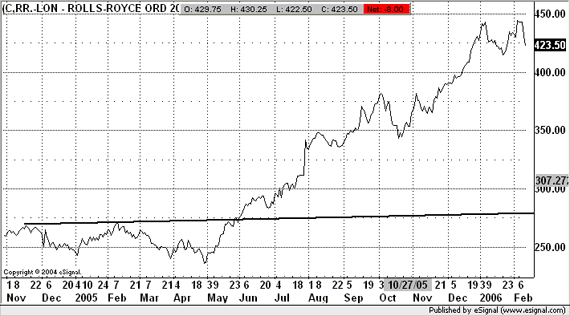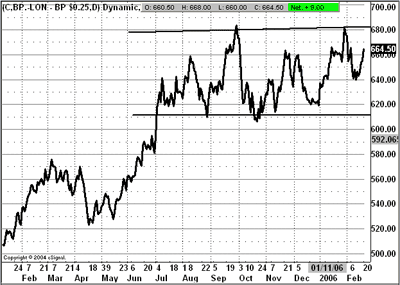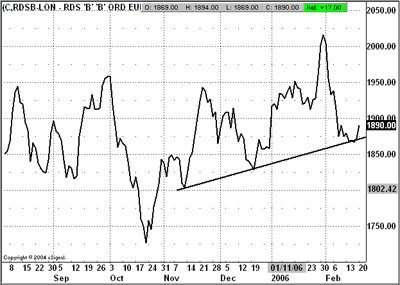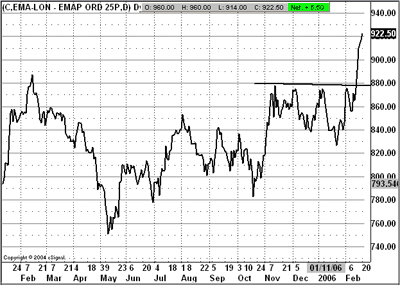This study aimed at beginners or those with no knowledge at all and also at intermediate investors who wish to improve their returns. The author of this study is veteran stockbroker and spreadbetting guru Charles Vintcent. Charles is the author of the best-seller, How to Make Money from Financial Spread Betting.
The secret of winning at financial spread betting lies in your ability to master four main skills. You must learn how to forecast accurately the direction in which the share price or index is going. You have to be able to read and understand the strength or weakness of support and resistance levels. You must be able to forecast the amount of movement in a share price or index. Finally, you must have the self control both to refrain from betting if the signs indicate that there is not enough 'profit' potential before the price hits a support or resistance level, or to resist the temptation to bet when a price has broken out of a pattern until it has established a new one.
This means that you need to absorb the basics of technical analysis until it becomes second nature, and you apply the disciplines automatically without having to think about them. You should also understand the rudiments of fundamental analysis, and learn how to find the basic ratios and indicators that will help you to judge whether the management of any given company is making real profits for the shareholders as well as enhancing the net worth of the company.
Making money requires a certain amount of knowledge and a great deal of application. There is no get-rich-quick magic formula that will allow you to generate regular profits by having a spread bet now and then. If you do learn the business and apply the rules, it can be very rewarding and it is all tax free.
Pure chartists will tell you that there is no place for fundamental analysis in forecasting in which direction, and by how much a share price or index will move before it stops. To a large extent they are right, but there is a place for fundamental analysis, because it can be a great help in both finding a company that will be worth considering for a bet, as well as occasionally providing you with understandable and sensible reasons for a sudden and unexpected change of direction in the price movement that perhaps seems to be illogical.
An example of this occurred in the past when the quarterly reports of ICI showed a totally unexpected loss in profits for the last quarter. The price dropped by a large amount, partly because there was some panic selling, and partly because the market makers overestimated the volume of shares that sellers might dump on them. Never forget, markets are driven by fear and greed, and prices reflect what investors expect to happen over the next six months. Share prices have little or no bearing on the true value of a company or market at any one moment; they reflect what investors think they are worth.
Consequently, it was fairly obvious to anyone who had failed to panic that the level to which the price had fallen was an aberration because the drop in profits was a technicality, due to a change in accounting procedures, and had nothing to do with disaster or bad management. It was a splendid opportunity to jump in and ride the price back up to its previous level which it achieved within six weeks. The price recovered by over 100p and large profits were made for those who placed a buy bet at £10 per 1p. Pure technical analysis would not have shown the understandable and acceptable reasons in this instance which reinforced the decision to bet on a recovery.
This example also goes to reinforce one of the golden rules which, if followed, will help to reduce your risk of loss and enhance your chances of winning.
You must become as knowledgeable about a company that you choose to follow as are the management of that company.
Ideally, you should understand its products, its markets, its competitors, its strengths and weaknesses, and above all its management record. This sounds daunting, but there are some simple and quick ways to get a very good idea about the 'feel' of the management. Remember, companies don't run companies; management does.
The first thing to do is to get a copy of the company's Report and Accounts for the last five years. You can get these free from the company's registrars. Carryout the following simple calculations for each of the last five years and see if the figures are getting better or worse.
Look at the 'contingent liabilities'. If the latest figure is large in comparison to the issued capital (say 10 per cent or more) and has been growing over the period, go no further. Find another company.
Read the chairman's reports. Reject any company where the chairman uses such words as 'should', 'might', 'it is hoped that...' because it means that he does not have a great deal of faith in the company's future.
If the auditors have qualified the report in any way, stop. Find another company.
Earnings Per Share (EPS). After adjustment for inflation the eps should be increasing each year.
Return On Capital Employed. Probably the most important and telling of all measurements by which to judge management's efficiency and capability. You obtain this by using the following calculation.
Operating (or Trading) profit X 100 = ROCE %
Capital Employed
This figure should be getting larger every year If it is reducing, i.e. the trend is downwards, stop and find another company.
Net Asset Value (NAV). This figure shows the net asset value of each ordinary share. It does depend very much, however, on the asset values in the balance sheet being realistic. This is how you calculate the NAV.
Ordinary capital plus reserves = NAV
No. of ordinary shares in issue
The NAV record over five years should correspond with that of the ROCE.
These quick calculations will show you whether the company's fortunes are rising or falling and it is always important to look back as far as you can to get a good picture of the management's success or otherwise.
There are over 3,000 companies listed on the London Stock Exchange, a whole lot more on the AIM market, thousands of futures to trade in, including equities, commodities, metals, currencies and indices. You cannot possibly win over a period if you dabble in these markets from time to time. You MUST know all about the strengths and weaknesses as well as the potential political and economic pressures that can affect current prices in your chosen investments otherwise the risks will far outweigh any possible rewards. It is physically impossible to absorb all the data needed to make low risk choices from all of these possible investments.
Apart from reading quality financial columns in the better daily press, you should buy the Saturday edition of the Financial Times. Otherwise you can follow the methods of the fund managers in the major short term investment houses and scan through charts very quickly very often. But you will find this somewhat time consuming and it is better to stick to those companies in one, or at the most two sectors in which you intend to specialize and really get to know. For this approach you have to apply technical analysis.
Technical analysis relies principally on graphs and charts for its data base. Most people find it much more convenient to see the progress of a share price graphically rather than a series of numbers. If you know how to read a graph properly, it takes just a few minutes to scan through a fairly large number of charts and, with practice, you will be able to pick out the ones that are exhibiting interesting signals. When you find one that is showing good signs (falling as well as rising, as well as strong momentum), go back and look at the performance over the last five years minimum, preferably the last ten. There are several chart patterns that you need to recognize instantly and to know what they are predicting. These are the main ones.
You have to know whether the short term trend (the last few weeks) is following the same pattern as the longer term one. If you look at the chart for BT over the last 10 years you will see that in the early period the growth rate of the share price was rising at an annual rate of YY %. Suddenly the price erupted to a high of 1500p over the next two years, and then dropped back to 200p. This chart illustrates some very important lessons which the beginner will do well to learn. First, it is essential to establish the direction and strength of the trend - 'let the trend be your friend'. Second, share prices fall at a faster rate than that at which they rise. Third, if you get it wrong, get out quickly.
 |
The trading range is demonstrated by joining the 'highs' and 'lows' of the share price with two lines which must be parallel. They can be horizontal, or sloping upwards or downwards, and the difference in money between the top and bottom line is called the trading range. The chart showing the price history of Rolls Royce ordinary shares illustrates this very well.
 |
You can see that from mid November 2004 until the end of May 2005, the price oscillated between around 240p and 275p, a movement of +14% and -12.7%. This pattern would have allowed you to make winning bets, once it had become established. You must always wait to see whether it turns upwards again when it hits the bottom of the trading range (known as a support level) before opening again with a 'buy' bet. In the same way, you should not close the downward bet or the upward bet until the price has turned (at the resistance level), in case a chart breakout occurs. If it does, whether up or down, you would continue to ride with the price making even greater profits, until it does run out of steam and turn in a different direction.
Such a breakout is shown on the same chart at the end of May when the price ran up to nearly 350p from 240p. When that happens, you must not continue to bet until a new pattern has become established. In this case, a steady upward trend set in with a new set of parameters with which to measure the new trading range.
The share price history will produce a pattern which will show levels at which the price is supported when it is dropping, and those which resist further increase in value. These levels are known as support and resistance levels and they indicate the level at which you can expect the upward or downward movement to stop. Sometimes, if the pressure driving the share price upwards or downwards becomes too great, the price will run through the resistance or support levels, and then the next one will be an indication of where the price may stop. These levels will be relatively strong or weak because they are known as Fibonacci calculations. If you are considering opening a bet when the price is close to a resistance or support level, you should always wait to see if the level is penetrated before committing yourself. Sometimes the level is penetrated by a small amount before the price changes back to its previous pattern, so it is important to make sure that a new pattern really is becoming established.
 |
Reverse Head & Shoulders and Head & Shoulders
This is a well known shape and both can be seen in the chart below.
 |
There is a rule that the spread bettor will do well to remember. The measurement of the distance in pence / currency between the 'shoulder' and the head (peak) will equal the distance that the share price will reverse from the head. For example, if the distance from a head (pointing upwards) to the shoulder is 50p, the price will fall back by 50p. The same will apply exactly to the reverse, when the price will recover by climbing back upwards by the same amount as it fell from the shoulder to the head. This pattern is an open invitation to make money, and the signal is a very strong one.
This is one of the most important aspects to look for when you are scanning through the charts. Momentum is recognized by the share price oscillating upwards and downwards frequently and by large amounts of movement. It means that you have a very good chance of making winning bets regularly by betting on the upward and downward movement since you can see the pattern easily and anticipate when the price will turn as well as estimating by how much it will rise and fall. The chart shows this clearly.
 |
In this chart you can see two head & shoulders, three reverse head & shoulders, several double bottoms, support and resistance levels, an established trading range and a chart breakout to a new 'high'.
MACD is constructed by making an average of the difference between two moving averages. The difference of the original two moving averages and the moving average of the difference can be plotted as two lines, one fast and one slow.
Most modern charting software now includes MACD as standard. It normally shows up as two lines plotted on an open scale against the zero line. These two lines will normally be of different colour or one line a solid line and the other a dotted line. Frequently used settings are 12 and 26 period exponential moving averages with 9 period exponential moving average as the signal line.
Although there are three moving averages mentioned you will only see two lines. The simplest method of use is when the two lines cross. If the faster signal line crosses above the slower line then a buy signal is generated and vice versa. It is also used as an overbought and oversold indicator. The higher above the zero both lines are the more overbought it becomes and the lower below the zero line both lines are the more oversold it becomes. The easiest way to regard this tool is to remember that normally share prices rise or fall in steps - very rarely in an absolute straight line. Consequently, as the name suggests, the price tends to diverge away from the average, and return towards the average, sometimes crossing above or below the average price line. It tends to do this because of the pressure exerted on the price by either an excess of demand over supply, or an excess of supply over demand. The great attraction of using the MACD is that it is a visual display of a prediction of a change of direction in the price trend.
It may also lead to a stronger signal if the signal line crosses down when it is overbought and crosses up when it is oversold. The last common use of MACD is that of divergence. If the MACD is making new lows and the price of the security is not making new lows that is one form of divergence (bullish divergence). Also, if the MACD has made a high and starts to head down but price continues up that is another type of divergence (bearish divergence) and may lead to an indication of a change in direction. Since the whole art of making money from financial spread betting relies on being able to predict both changes in the direction of price movement, and in the distance up or down that the price is likely to move, any aid that will help in making these forecasts is welcome. It is very useful if you combine the picture of the chart on your screen showing the trend and trading range of the share price over the last two or three months, with the MACD underneath for the same period. You will get advance warning of an imminent change in direction and, depending upon the distance the current share price is from the resistance or support level, you can easily work out whether there is enough 'room' left to make a bet that will have sufficient potential movement in it to make a good profit.
Many spreadbettors roll over their bets to another period, particularly day bets. This practice will incur a small extra cost, but it can be very useful if you have hit a sustained run. For example, suppose you have decided that the Daily Dow is overpriced and due for a correction. You open with a 'sell' bet, and the news programs start to back up their reporting of the falling index with stories of widely expected bad results from large corporations over the next few days. You think that the Dow will continue the slide next day, so rather than close the bet at the end of the day's trading, which would happen naturally, you ask the bookmaker to roll over the bet until the close of business the next day, or until or if you close the bet before that time.
Everyone wants to make profits; no one likes to lose money. You can reduce the risk of loss substantially if you follow some golden rules and apply strict self discipline to your spread betting management.
The content of this site is copyright 2016 Financial Spread Betting Ltd. Please contact us if you wish to reproduce any of it.